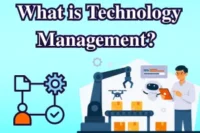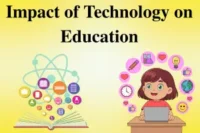Types of Digital Technology: Examples, Applications, & Benefits
Published: 30/Sep/2025
Digital technology is a key part of our lives, shaping how we communicate, work, learn, and live. From online classrooms and remote work to AI tools and smart devices, it touches every aspect of daily life.
In this article, we’ll explore the main types of digital technology, real-world examples, sector applications, and future trends—giving students, professionals, and business leaders valuable insight to use technology more effectively. So, let’s dive in.
What Are the Main Types of Digital Technology?
Digital technology comes in many forms, each with its own unique impact and applications across different sectors. Let’s look at the main digital technology types
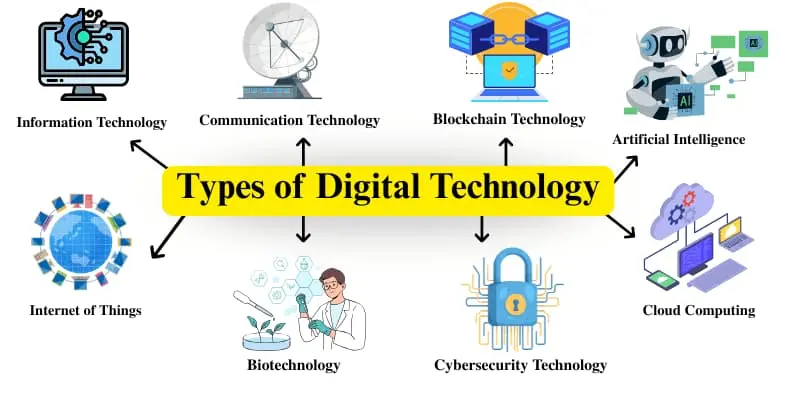
1. Information Technology (IT)
IT refers to using computers, software, and networks to store, manage, and transmit information. It’s the basis of modern data management and business operations.
| Pros: |
|---|
|
| Cons: |
|---|
|
Best For:
Businesses handling large volumes of data, remote workers needing reliable communication tools, and students working on research projects.
2. Communication Technology
Communication technology refers to the digital tools we use to connect and communicate with others, whether through email, messaging apps, or video calls.
| Pros: |
|---|
|
| Cons: |
|---|
|
Best For:
Businesses communicating with clients, online education for students, and professionals working remotely.
3. Artificial Intelligence (AI) & Machine Learning
Artificial Intelligence (AI) involves creating machines that can perform tasks usually done by humans, like understanding language, making decisions, and solving problems. Machine Learning (ML), a part of AI, enables machines to learn from data and experiences, allowing them to improve their performance over time without needing to be manually programmed.
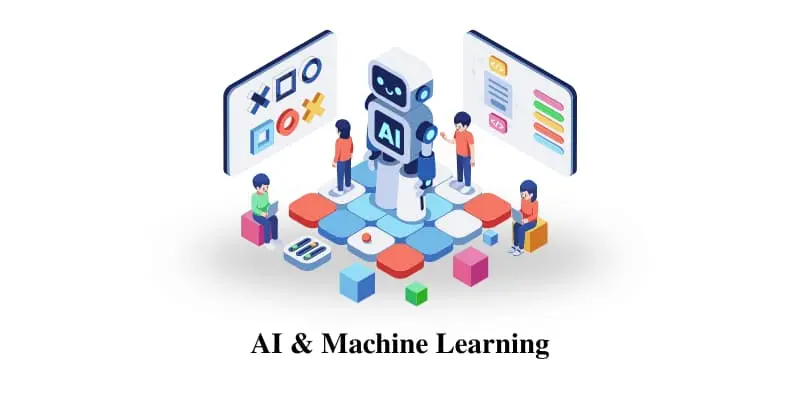
| Pros: |
|---|
|
| Cons: |
|---|
|
Best For:
Data analysis, customer service automation, and personalized learning experiences in education.
4. Internet of Things (IoT)
The Internet of Things (IoT) connects physical devices like home appliances, vehicles, and wearables to the internet, allowing them to share data and communicate. This makes tasks like home automation and industrial monitoring more efficient.
| Pros: |
|---|
|
| Cons: |
|---|
|
Best For:
Smart homes, fitness tracking, and industries like healthcare and manufacturing that rely on real-time data.
5. Cloud Computing
Cloud computing allows users to store and access data over the internet, without relying on physical hardware or storage devices.
| Pros: |
|---|
|
| Cons: |
|---|
|
Best For:
Businesses needing scalable storage, educational institutions for e-learning, and individuals requiring remote access to their data.
6. Blockchain Technology
Blockchain is a decentralized digital ledger that records transactions securely and transparently, commonly used in cryptocurrencies like Bitcoin.
| Pros: |
|---|
|
| Cons: |
|---|
|
Best For:
Cryptocurrencies, secure digital contracts, and supply chain management.
7. Virtual Reality (VR) & Augmented Reality (AR)
Virtual Reality (VR) creates an immersive, fully digital environment, often used for training and entertainment purposes. Augmented Reality (AR), on the other hand, overlays digital content onto the real world, enhancing the user’s experience with additional information or interactive elements.
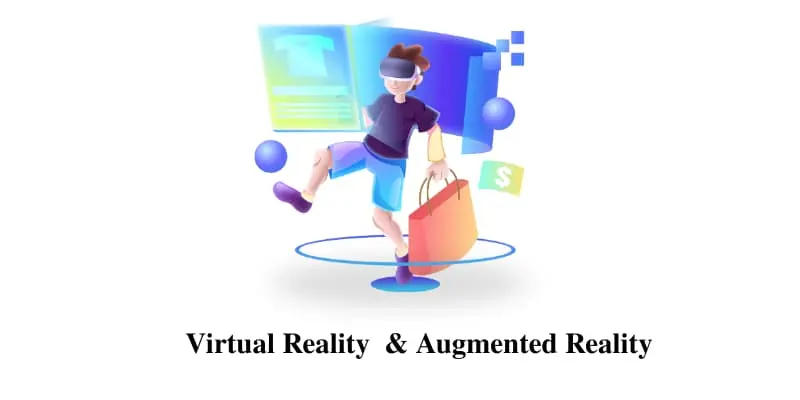
| Pros: |
|---|
|
| Cons: |
|---|
|
Best For:
Education, healthcare (for training simulations), and marketing (for immersive ads).
8. Robotics & Automation
Robotics involves machines performing tasks traditionally done by humans. Automation uses technology to carry out repetitive tasks without human intervention.
| Pros: |
|---|
|
| Cons: |
|---|
|
Best For:
Manufacturing, healthcare (robotic surgeries), and logistics.
9. Biotechnology & Health Tech
Biotechnology uses digital technology to advance medical research, while health tech improves healthcare outcomes using digital tools and systems.
| Pros: |
|---|
|
| Cons: |
|---|
|
Best For:
Hospitals, telemedicine services, and health-conscious individuals.
10. Cybersecurity Technology
Cybersecurity technology safeguards digital systems and data from cyber threats, ensuring that information remains secure from unauthorized access.
| Pros: |
|---|
|
| Cons: |
|---|
|
Best For:
Businesses with sensitive data, healthcare providers, and financial institutions.
Applications of Digital Technology in Different Sectors
Digital technology is changing industries by improving efficiency, reducing costs, and enhancing customer experiences. Here’s how different sectors are benefiting.
1. Business
Digital technology is driving innovation in the business sector by enhancing operations, improving customer service, and enabling better decision-making.
Applications:
- Cloud Computing: Allows businesses to store data online, ensuring easy access and collaboration from anywhere.
- Data Analytics: Helps businesses understand customer behavior, optimize operations, and predict market trends.
- Customer Relationship Management (CRM) Systems: Utilizes customer data to improve service, boost loyalty, and personalize marketing efforts.
2. Education
Digital technology is transforming education by making it more accessible, interactive, and adaptable.
Applications:
- E-Learning Platforms: Offer a variety of courses online, making education accessible to a global audience.
- Virtual Classrooms: Allow teachers and students to interact in real-time, regardless of geographical location.
- Educational Apps & Tools: Provide interactive learning experiences, from coding lessons to language learning.
3. Healthcare
The healthcare sector is increasingly adopting digital technologies to improve patient care, streamline operations, and ensure data security.
Applications:
- Telemedicine: Facilitates remote consultations, improving access to healthcare for those in rural or underserved areas.
- Robotic Surgery: Provides accurate and less invasive procedures, reducing recovery times.
- Electronic Health Records (EHRs): Simplifies patient data management, allowing faster diagnosis and treatment.
4. Agriculture
Digital tools are helping farmers increase crop yields, monitor conditions in real-time, and manage resources more effectively.
Applications:
- Precision Farming: Uses sensors and GPS technology to monitor soil health, crop growth, and weather conditions.
- Drones: Help in crop monitoring, pest control, and even irrigation.
- Farm Management Software: Helps track crop performance, manage resources, and optimize farming operations.
5. Transportation
Digital technologies are reshaping transportation by making travel safer, faster, and more efficient. From navigation tools to self-driving vehicles, these innovations are transforming how people and goods move.
Applications:
- GPS & Navigation Systems: GPS technology helps drivers and businesses plan efficient routes and avoid traffic delays. For example, apps like Google Maps and Waze provide real-time traffic updates, saving time and fuel.
- Smart Traffic Management: Many cities now use IoT sensors and AI-powered systems to monitor road conditions and control traffic signals. This reduces congestion and improves road safety. Singapore and London, for instance, are global leaders in adopting smart traffic solutions.
- Autonomous Vehicles: Self-driving cars and trucks can reduce human error, lower costs, and improve road safety. Companies like Tesla and Waymo are already testing them, pointing to a future of automated transportation.
6. Entertainment
Digital technology is transforming the entertainment industry, providing new ways for consumers to access and interact with media content.
Applications:
- Streaming Services: Platforms like Netflix, Spotify, and YouTube offer on-demand access to movies, music, and TV shows, revolutionizing how we consume entertainment.
- Virtual Reality (VR): Provides immersive experiences in gaming, films, and virtual tourism.
- Content Creation Tools: Advances in video editing, animation, and graphic design software allow creators to produce high-quality content with ease.
Examples of Digital Technology
These are a few examples of digital technology used across many industries.
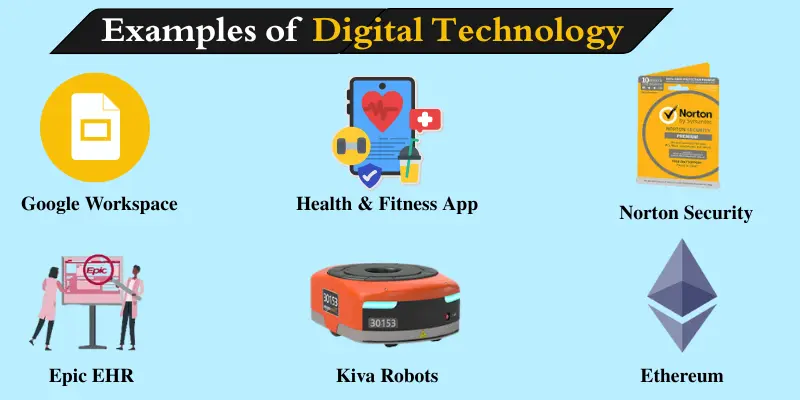
1. Google Workspace (IT & Communication)
A suite of cloud-based productivity tools that allows real-time collaboration, including Gmail, Docs, Sheets, and Meet.
2. Zoom (Communication Technology)
A video conferencing platform used for remote meetings, webinars, and virtual collaboration.
3. IBM Watson (AI)
A powerful AI platform that provides data analysis, natural language processing, and machine learning capabilities for businesses.
4. Fitbit (IoT & Health Tech)
A wearable device that tracks physical activity, health metrics, and connects to apps to monitor overall wellness.
5. Dropbox (Cloud Computing)
A cloud storage service that allows users to store and share files securely across multiple devices.
6. Ethereum (Blockchain)
A decentralized platform for building and running smart contracts and decentralized applications (dApps), primarily used for cryptocurrency transactions.
7.Oculus Rift (VR)
A virtual reality headset that offers immersive experiences for gaming, entertainment, and training simulations.
8. Kiva Robots (Automation)
Autonomous robots are used in warehouses to automate the picking and sorting of items, improving logistics efficiency.
9. Epic EHR (Healthcare Technology)
An electronic health record (EHR) system that helps healthcare providers manage patient data and improve care coordination.
10. Norton Security (Cybersecurity)
A comprehensive security suite that protects devices from viruses, malware, and other online threats.
These examples show how digital technology touches nearly every part of modern life, from business and healthcare to entertainment and security.
Future Trends in Digital Technology
Here are some key trends that highlight where digital technology is headed in the near future.
- Advancements in AI and Machine Learning: AI and machine learning are becoming smarter, helping in predictions, healthcare, automation, and customer service.
- 5G and IoT: 5G offers faster speeds, making smart devices like sensors, cameras, and connected cars work in real time.
- Cloud Adoption: More people and businesses use cloud solutions for cheaper storage, easy access, and better teamwork.
- AR/VR in Education and Business: AR and VR are used for practical learning, training, and interactive business presentations.
- Blockchain Beyond Finance: Blockchain is now used for secure records, transparent supply chains, and safe voting systems, not just cryptocurrency.
Conclusion
Digital technology is transforming every aspect of modern life, from education and healthcare to business and entertainment. Understanding the types of digital technology, their applications, and benefits helps students, professionals, and leaders make better use of these tools. With technology always changing, staying updated is important for anyone who wants to succeed today.
Stay curious and keep learning to stay ahead in the digital world.
Frequently Asked Questions
Below are answers to some common questions about the different kinds of technology :
Digital technologies in education include e-learning platforms, virtual classrooms, and interactive apps. These tools help students learn online and engage with lessons in real time. AI-based learning tools also personalize the learning experience for each student.
Businesses use various digital technologies like IT, AI, IoT, cloud computing, and blockchain. These tools help businesses operate more efficiently and make smarter decisions. Communication technology also helps businesses stay connected with clients and employees.
Digital technologies in healthcare include telemedicine, which allows remote doctor visits. Wearable health devices track a person’s health in real time, and AI helps diagnose diseases faster. Electronic Health Records (EHR) make it easier for doctors to manage patient data.
Digital technology simplifies everyday tasks like communication and shopping. It supports education by providing online learning tools and helps improve healthcare with telemedicine and health monitoring apps. Additionally, it boosts economic growth and connects people globally.



